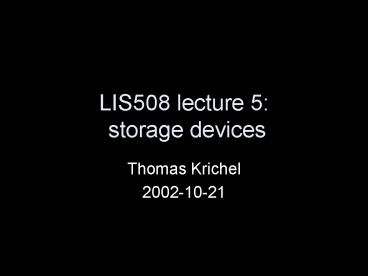LIS508 lecture 5: storage devices - PowerPoint PPT Presentation
Title:
LIS508 lecture 5: storage devices
Description:
LIS508 lecture 5: storage devices. Thomas Krichel. 2002-10-21. Today we have ... backup utility is based in the 'system tools' section of programs/accessories. ... – PowerPoint PPT presentation
Number of Views:34
Avg rating:3.0/5.0
Title: LIS508 lecture 5: storage devices
1
LIS508 lecture 5 storage devices
- Thomas Krichel
- 2002-10-21
2
Today we have fun with
- Disks
- Files, directories and links
3
Files, directories and links
- Files are continuous chunks data on disks that
are required for software applications. - Directories are files that contain other files.
Microsoft calls them folders. - A link is a file that contain the address of
another file. Microsoft call it a shortcut.
4
Structure of a disk
- Disks are round devices divided into tracks and
sectors. - A hard disk may have several physical disks.
- Sector is 571 bytes long
- 512 bytes are used by the user
- The rest is reserved for disk operation
- The disk spins, a head reads and writes data.
5
Data integrity
- The special data in each sector is kept there to
try ensure that the user data is safe. - It contains a summary of the user data.
- When the summary and the user data no longer
match, the summary can be used to correct the
user data. - SMART disks are those that can monitor if they
are a in good shape.
6
Formatting a floppy
- Physical formatting
- writing tracks
- writing sectors
- Logical formatting
- labeling each sector
- create boot record
- create file allocation table (FAT)
7
Formatting a hard disk
- That is the same as formatting a floppy but
- Between physical and logical formatting, the hard
disk may be partitioned. - This allows for several logical disks on the same
physical disk - Therefore the boot record is more complicated
than on the floppy and called a master boot
record MBR. - Example dual boot Linux/Windows machine
8
Windows logical disks
- Floppies use FAT12 format
- The boot records is exactly one sector long
- therefore called the boot sector
- Does not allow for long file names
- The logical disks on a hard disks may use FAT32
format if larger than 512Mb - System area
- Boot record
- FAT
- User area
- Can handle disks of the size of 2 tera bytes
9
NTFS
- Is the file system for windows NT.
- In windows XP, Microsoft have limited FAT32 to a
capability to handle disks up to 8 Gb, to
encourage the use of NTFS. - NTFS is a better file system
- FAT is in the middle
- Fragments less
10
The root directory
- Like a directory in the ground floor of a
Manhattan building. - Root directory does not know where the file is
stored, that is in the FAT. - Root directory is called drive\ in windows,
where drive is a letter identifying the drive. A
drive is a physical device or a logical device
found on a physical device. - The directory separator in Windows is \.
11
Unix file conventions
- In UNIX the root directory is /.
- / is the directory separator.
- A number of special files in /dev represent
devices. - Each device is mounted as a subdirectory of the
root directory. Example - mount /dev/fd0 /floppy
12
Long and short file names
- DOS only had eleven byte file names, 8 for main
name and three for the extension - Names could be uppercase letters, numerals, and
some other symbols. - There is a generated short name that is used when
windows writes to a disk that has a fat that does
not support long names. - All modern Windows versions use unicode for file
names.
13
Folders in Windows
- Rightclick, new allows you to create a new folder
or shortcut - Within a folder you can have different views of
the files - large icons (default)
- list, column
- Small icons, line)
- Details, shows date, type
14
copy
- Either right-click and drag, select copy here
- Or use right-click cut, and then you can paste
it. - To delete, right-click and delete.
- And then go to the recycling box and delete it
from there. Otherwise no free space is created.
15
Sort items
- You can arrange icons by
- Name
- Type
- Size
- Date
- You can set auto arrange on (see tick mark)
16
Windows explorer
- Shows directory tree and files in the current
folder - Width of both parts can be customized
- next to a folder suggests that it contains
further folders - Clicking on the plus can make the extra folders
appear.
17
Finding a file
- Find / files or folders
- Either name or substring
- Date range
- Type
18
backups
- There is a song of the Beatles
- The backup utility is based in the system tools
section of programs/accessories. - It also has an emergency repair tool, that lets
you fix things. - It is best to define a backup job, and then run
it at scheduled times. - Time between jobs needs to be chosen with care.
19
Next week
- video
20
http//openlib.org/home/krichel
- Thank you for your attention!































